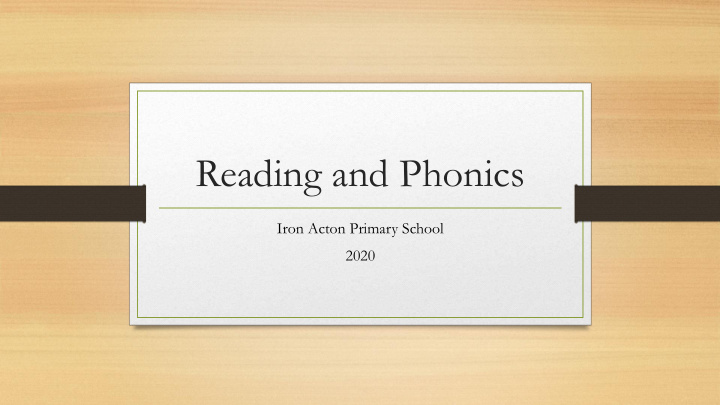



Reading and Phonics Iron Acton Primary School 2020
Aims of the session • Introduce new reading scheme • Discuss how the books can be utilised at home • Discuss how we teach phonics in school • Discuss how phonics can be supported at home
Reading Scheme • Supplied by Big Cat Phonics • In line with the current Ofsted and government requirements • All books sent home are fully decodable and in line with the sounds they are learning • Any common exception words (non-decodable words) are highlighted in the inside front cover, alongside the sounds that are included in the book • There are prompts on the inside covers of each book to aid discussion of the story structure and story.
Reading in School • Children are listened to by teachers and support staff in small reading groups at least once a week • Each book is read 3 times • Books are an integral part of the classroom – the class bookcase in always accessible and children are read to every day • Class books are often used for inspiration in writing and other foundation activities • All children are assessed three times a year using the assessments from the Big Cat Phonics scheme.
Importance of Reading at Home • The school expectation is for each child to read 5 times a week at home • Please write in the yellow reading records every time you read with your child • In Year 1 and 2, a new book will be given on a Monday, with additional books on Wednesday and Friday if needed. These three books can then be re-capped over the weekend • Reception books will be changed as needed • Each book is read three times • First read: decoding words • Second read: reading with meaning • Third read: comprehension – discussing the text or story • A variety of books outside of the school reading scheme is also encouraged to promote a love of reading – it shouldn’t be a chore!
Phonics • Phonics is taught daily • We use a variety of methods, games and activities to help children learn the sounds, e.g. interactive games, songs, flashcards etc. • Reception have a red sound book with their sounds to practice at home • Year 1 and 2 have spelling books with their sounds / words to practice at home.
s a t p i n snake ant tennis pink ink net m d g o c k mum dad gurgle on / off click click e u r h b f egg umbrella rag hop bat fish l j v w x y lollipop jelly van wind fox yoghurt z qu ng ch sh th zip quack strong chip shop thumb ai oa igh ee or ar rain goat light sheep thorn farm oo oo ow oi ur air book moon cow coin turn chair ck er ear ure Double letters make the rocket flower hear manure longer sound e.g. ‘ zz ’, ‘ll’, ‘ ff ’, ‘ ss ’
fish f i sh
Phonics Terminology • Phoneme – the smallest unit of sound in a word, often referred to as a sound • Grapheme – a letter or sequence of letters that represents a phoneme • Blend – squashing the sounds together to make larger units such as syllables or words, e.g. c-a-t = cat • Sound – saying the phoneme that each grapheme represents in order to blend them • Segment – breaking words, or parts of words, into the components of sounds (phonemes), e.g. cat = c-a-t • Digraph – a phoneme that it represented by two letters, e.g. ee • Trigraph – a phoneme that is represented by three letters, e.g. igh • Split digraph – a digraph that is separated within a word, e.g. e-e = theme
Recommend
More recommend